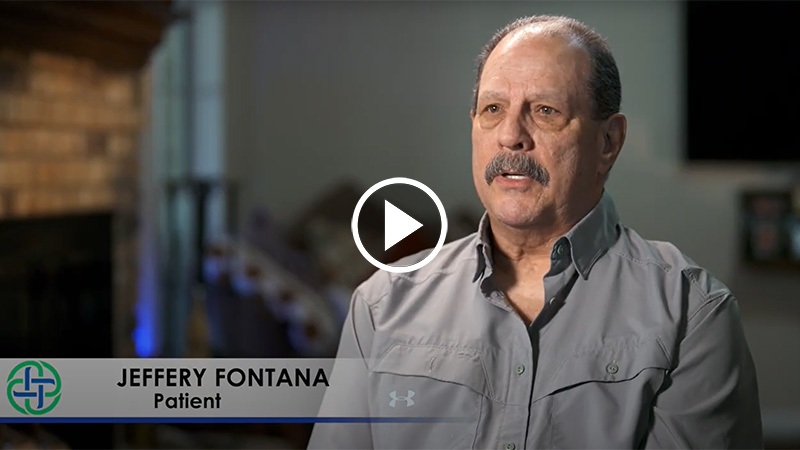The knee joint is among those most commonly affected by osteoarthritis as a result of joint wear and tear. The American College of Rheumatology estimates that about 14 million Americans live with the symptoms of knee arthritis. Until recently, Jeffrey Fontana was one of them.
The 67-year-old Burleson resident is now retired, but he’s never been one for being idle. Jeffrey loves to hunt, take care of his family’s ranch in West Texas and, most importantly, try to keep up with his 10 grandchildren. He had dealt with pain in both his knees since playing high school football. A little rest and aspirin would usually do the trick for the pain.
Watch Jeff's Story
In recent years, however, Jeffrey found he couldn’t walk at times. “I had to sit everywhere I walked,” he says. “I had to stay home when my wife went on vacation with our grandkids, or to football games, or birthday parties, or just anything that would have me walking a long way.”
The pain in his knees became increasingly frustrating when Jeffrey and his wife traveled. He remembers his wife having to push him through the airport in a wheelchair at one point. He then turned to knee injections to help deal with the discomfort, but even those stopped working after a time.

Looking for a better quality of life, Jeffrey sought the help of orthopedic surgeon and joint replacement specialist Hugo Sanchez, M.D., at Texas Health Orthopedic Specialists, a Texas Health Physicians Group practice in Fort Worth. Imaging scans showed Jeffrey’s knee joints were bone-on-bone and had been for years, leading to an advanced stage of osteoarthritis.
“Jeff presented a little bit of a complicated scenario because he not only had arthritis on one knee but both knees were involved, and both knees were involved to a similar level,” Sanchez explains.
Healthy knee joints have a layer of tissue, or cartilage, inside that covers the surface of the bones and allows for smooth gliding of the joints. The joints also contain a fluid which cushions the end of the bones and helps reduce friction with movement. In Jeffrey’s case, the cartilage in the knees had thinned, causing the surface of the joints to become rough. The result was some serious pain, stiffness, and bow-leggedness.
Joint Replacement and Beyond
Because Jeffrey was willing to commit to the surgical process and whatever it took to recover, Sanchez recommended replacement of both knees at the same time. During the procedure, Jeffrey’s knees were resurfaced allowing for removal of damaged cartilage and bone in the diseased areas only. This enabled him to recuperate relatively quickly.
Just two hours after surgery, Jeffrey was up walking the hospital halls. Two weeks after his surgery, he was undergoing physical therapy and getting around with a cane.
“By resurfacing the knee, that allows for improved movement as well as restoration of alignment,” Sanchez says. “So, in [Jeffrey’s] case, he was bow legged and we fixed that. Now his legs are straight.”
Seven months after his surgery and a dedicated rehab routine, Jeffrey is living life pain free. “It’s fantastic. I can do anything I want to do. I can do everything around the house.”
He says he is thankful to Sanchez, who had a great bedside manner and provided the information he needed to get better. “My future looks great. We’re fixing to go back to Italy. I’m going to walk through Italy again.”
Find a joint care specialist today who can assist with your joint pain. Or to learn more about your joint health, take our hip and knee health assessment.
Providers employed by Texas Health Physicians Group are not employees or agents of Texas Health Resources hospitals. © 2024 Texas Health Resources.


